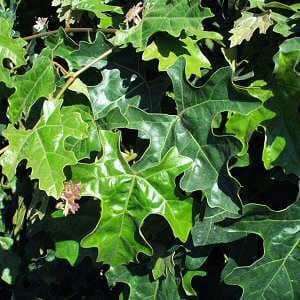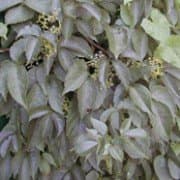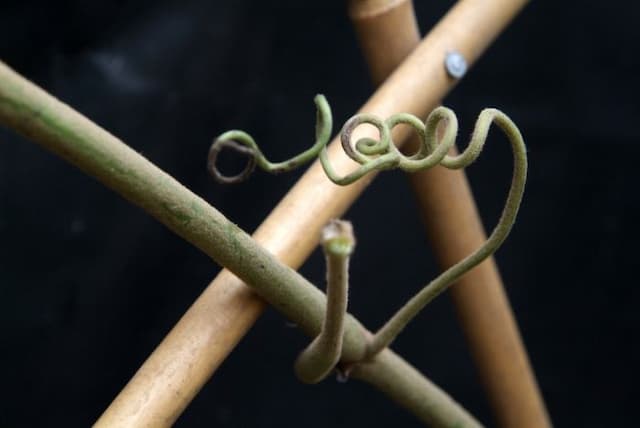Boston Ivy Parthenocissus tricuspidata 'Veitchii'

ABOUT
The Boston Ivy is renowned for its vibrant and decorative foliage. It showcases a dynamic range of colors through the seasons, making it an appealing choice for adding life to walls, fences, and trellises. During the spring and summer months, its leaves are a lush, glossy green, which makes for a dense and vibrant green coverage. In autumn, this ivy becomes truly spectacular. The leaves transform into a captivating display of reds, oranges, and yellows, bringing a fiery warmth to the cooler days of fall. The leaves themselves are shaped in a way that is reminiscent of three-pointed stars, with each leaf exhibiting three clearly defined sections that emanate from a central point, giving them a somewhat jagged and angular appearance. This distinctive leaf shape contributes significantly to the Boston Ivy's visual interest. Furthermore, the plant is known for the tendrils that allow it to climb and adhere to surfaces. These tendrils end in adhesive-like tips, which enable the Boston Ivy to 'stick' to walls and other structures without the need for additional support. This self-clinging capacity is significant because it allows the plant to cover expansive surfaces, creating a lush and comprehensive green façade during the growing seasons. Additionally, the plant produces small, inconspicuous flowers that are generally overshadowed by the foliage. Following the flowering phase, the Boston Ivy may produce small, dark blue berries that can attract birds and wildlife. The transitions of the Boston Ivy's colors from season to season, along with its ability to form dense mats of foliage, makes it a favorite for those seeking to add texture, color, and life to their gardens or urban environments. Because of its seasonal changes and adaptability to cling to various structures, it is commonly used to beautify buildings, cover walls, or provide shade when grown over pergolas or arbors.
About this plant
 Names
NamesSynonyms
Boston Ivy, Japanese Creeper, Grape Ivy, Japanese Ivy, Veitch's Ivy, Woodbine
Common names
Parthenocissus tricuspidata 'Veitchii'
 Toxicity
ToxicityTo humans
Boston Ivy is not considered highly toxic to humans. However, if ingested, it may cause stomach upset, vomiting, or diarrhea. The plant's sap contains oxalates that can irritate the skin, mouth, throat, and gastrointestinal tract if handled or consumed.
To pets
For pets, Boston Ivy can also be problematic. If ingested, it may cause vomiting, diarrhea, and abdominal pain due to the presence of oxalates. It can also potentially cause skin irritation if your pet comes into contact with the sap. It is advisable to prevent pets from chewing on the plant.
 Characteristics
CharacteristicsLife cycle
Perennials
Foliage type
Deciduous
Color of leaves
Green
Height
30 feet (9.14 meters)
Spread
5 feet 10 inches (1.78 meters)
Plant type
Climber
Hardiness zones
4
Native area
Asia
Benefits
 General Benefits
General Benefits- Aesthetic Appeal: Boston Ivy adds vibrant greenery during spring and summer, and its leaves turn to attractive shades of red and purple in the fall, enhancing the visual interest of any landscape or garden.
- Coverage: It is an excellent plant for covering walls, fences, trellises, and other structures, which can help in creating a lush green backdrop or feature wall.
- Shade Creation: When grown over pergolas or arbors, Boston Ivy can provide a natural canopy that offers shade and reduces heat in the immediate area.
- Erosion Control: Its robust root system helps stabilize slopes and prevent soil erosion, making it useful for landscaping purposes in hilly or uneven terrains.
- Habitat for Wildlife: The dense foliage provides shelter and nesting sites for birds and other small animals, supporting local biodiversity.
- Seasonal Interest: Boston Ivy's seasonal leaf changes offer varied visual interest, providing an attractive feature throughout different seasons of the year.
- Architectural Enhancement: Its classic look can enhance the architectural features of buildings and can be used to soften or complement various styles of architecture.
 Medical Properties
Medical PropertiesThis plant is not used for medical purposes.
 Air-purifying Qualities
Air-purifying QualitiesThis plant is not specifically known for air purifying qualities.
 Other Uses
Other Uses- Wall and fence camouflage: Boston ivy can rapidly cover walls and fences, providing a green facade that can hide unsightly structures or provide a uniform aesthetic.
- Seasonal interest: With its striking fall color, Boston ivy adds visual interest to gardens, particularly in autumn when the leaves turn vibrant shades of red, purple, and orange.
- Nature-inspired decor: The leaves of Boston ivy can be used in floral arrangements or as inspiration for patterns in design and art for their distinct shape and color.
- Landscape design: It can be used in landscape architecture to create green walls or living murals that change with the seasons, adding dynamism to urban spaces.
- Educational tool: As a fast-growing climber, Boston ivy can be used to teach principles of plant growth and vine behavior in botany and horticulture classes.
- Acoustic improvement: Dense coverage of Boston ivy on walls can contribute to reduced sound reflection, helping to dampen noise in urban environments.
- Backdrops for photography: The dense, leafy growth provides a natural and lush background for outdoor photography and portraiture.
- Thematic gardening: Boston ivy can be used in "four seasons" gardens where the focus is on plants that provide interest throughout the year, with its ever-changing foliage.
- Urban wildlife support: The plant offers shelter and potential nesting sites for birds and insects within urban landscapes.
- Film and theater set design: Its ivy-covered appearance can be used in set design to evoke an old-world feel or to quickly establish a setting overgrown with vegetation.
Interesting Facts
 Feng Shui
Feng ShuiThe Boston Ivy is not used in Feng Shui practice.
 Zodiac Sign Compitability
Zodiac Sign CompitabilityThe Boston Ivy is not used in astrology practice.
 Plant Symbolism
Plant Symbolism- Growth: Parthenocissus tricuspidata 'Veitchii', commonly known as Boston Ivy, is symbolic of growth and expansion due to its vigorous climbing habit and its ability to cover large surfaces.
- Protection: The dense foliage of Boston Ivy can symbolize protection and shelter, as it often creates a green barrier on the structures it climbs.
- Adaptability: Boston Ivy symbolizes adaptability, reflecting its tolerance to different growing conditions and its ability to thrive in various environments.
- Perseverance: The plant's strong climbing nature and the way it holds onto surfaces can represent perseverance and tenacity in the face of challenges.
- Transformation: The changing colors of Boston Ivy's leaves from green to vibrant reds and purples in autumn can symbolize transformation and the cycle of life.
 Water
WaterThe Boston Ivy should be watered thoroughly, allowing the soil to become dry to the touch between waterings. It typically requires about 1 gallon of water every 7 to 10 days, but this can vary depending on the size of the plant and the environmental conditions. During the growing season in spring and summer, you may need to water more frequently, especially if the weather is hot and dry. In the fall and winter, reduce watering as the plant enters dormancy. Ensure that the plant has proper drainage to prevent waterlogging which can lead to root rot.
 Light
LightBoston Ivy thrives best in full sun to partial shade. It can adapt to a wide range of light conditions, but for the most vigorous growth and best fall color, a spot that receives at least 4 hours of direct sunlight is ideal. The plant can also tolerate shaded areas but may not grow as densely or have as intense fall coloration in deeper shade.
 Temperature
TemperatureBoston Ivy is hardy and can withstand a wide range of temperatures, but it prefers a temperate climate. It can survive in temperatures as low as -10°F and as high as 100°F, but it grows best when the temperature is between 60°F and 80°F. Ensure that the plant is not exposed to extreme cold without protection, especially when young.
 Pruning
PruningPrune Boston Ivy to control its growth and maintain a desired shape. The best time for pruning is late winter or early spring before new growth starts. It should be pruned annually to keep it from overwhelming structures and to remove any dead or damaged vine sections. If the plant is growing on a wall or fence, pruning helps prevent damage to the structure and keeps the foliage looking tidy.
 Cleaning
CleaningAs needed
 Soil
SoilThe Boston Ivy requires a well-draining soil mix, composed of garden soil, compost, and perlite or bark to facilitate drainage. The ideal soil pH for Boston Ivy is slightly acidic to neutral, ranging from 5.5 to 7.5.
 Repotting
RepottingBoston Ivy is a vigorous grower but does not need frequent repotting; it can be repotted every 2-3 years as it becomes root-bound or to refresh the soil.
 Humidity & Misting
Humidity & MistingBoston Ivy thrives best in average humidity levels; it is quite adaptable and does not require any special humidity considerations beyond typical indoor levels.
 Suitable locations
Suitable locationsIndoor
Place in bright indirect light and ensure support for climbing.
Outdoor
Plant in full sun to partial shade with a structure to climb.
Hardiness zone
4-8 USDA
 Life cycle
Life cycleBoston Ivy 'Veitchii' begins its life cycle as a seed that germinates in the spring after the last frost. The seedling then develops into a juvenile vine with distinctively shaped leaves, capable of rapidly climbing surfaces using adhesive pads at the tips of its tendrils. As the plant matures, it enters a vigorous vegetative stage where it grows extensively and can cover large areas if left unchecked. During summer, the mature vines produce small, inconspicuous flowers which, if pollinated, give way to dark blue to black berries in the fall. These berries are then consumed by birds, and the seeds are dispersed to new locations where they can germinate. The plant is deciduous, so it loses its leaves to reveal a striking reddish-brown frame in the winter before returning to its growing cycle the following spring.
 Propogation
PropogationPropogation time
Spring-Early Summer
The most popular method for propagating Boston Ivy (Parthenocissus tricuspidata 'Veitchii') is through stem cuttings. This method is best performed in the spring or early summer when the plant is actively growing. To propagate, you should cut a 5 to 6-inch (approximately 12.7 to 15.2 cm) length of stem that includes at least two sets of leaves. The lower end of the cutting should be dipped in rooting hormone powder to enhance root development. The treated end is then inserted into a pot filled with a moist, well-draining potting mix. The pot should be placed in a warm location with indirect sunlight and covered with clear plastic to maintain high humidity around the cutting. Roots typically develop within a few weeks, after which the new plant can be gradually acclimated to normal conditions before repotting or planting in its desired location.



![Grape [Claret Cloak]](/_next/image?url=https%3A%2F%2Fplants-admin.emdemapps.com%2Fimages%2Fplants%2F%2Fimages%2F604b602abe2f8.png&w=640&q=75)





